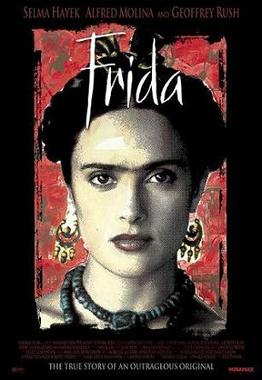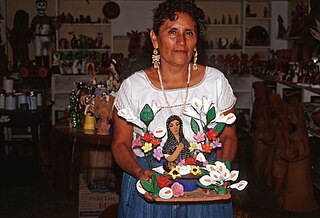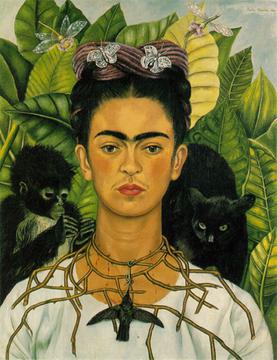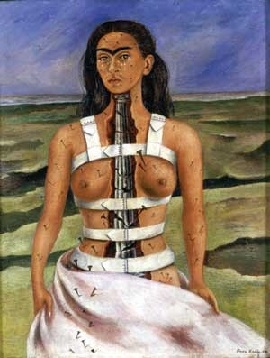
Magdalena Carmen Frida Kahlo y Calderón was a Mexican painter known for her many portraits, self-portraits, and works inspired by the nature and artifacts of Mexico. Inspired by the country's popular culture, she employed a naïve folk art style to explore questions of identity, postcolonialism, gender, class, and race in Mexican society. Her paintings often had strong autobiographical elements and mixed realism with fantasy. In addition to belonging to the post-revolutionary Mexicayotl movement, which sought to define a Mexican identity, Kahlo has been described as a surrealist or magical realist. She is also known for painting about her experience of chronic pain.

Frida is a 2002 American biographical drama film directed by Julie Taymor which depicts the professional and private life of the surrealist Mexican artist Frida Kahlo.

Lola Álvarez Bravo was the first Mexican female photographer and a key figure in the post-revolution Mexican renaissance. Known for her high level of skill in composition, her works were seen by her peers as fine art. She was recognized in 1964 with the Premio José Clemente Orozco, by the State of Jalisco, for her contributions to photography and her efforts to preserve the culture of Mexico. Her works are included in the permanent collections of international museums, including the Museum of Modern Art in New York City.

Dorothy Hale was an American socialite and aspiring actress who died by jumping off of the Hampshire House building in New York City. Her husband's death, followed by several unsuccessful relationships, had left her financially dependent on her wealthy friends. The artist Frida Kahlo created a famous painting commissioned by Clare Boothe Luce, titled The Suicide of Dorothy Hale.

Alice Phillipot (Alice Rahon) (8 June 1904 – September 1987) was a French-born Mexican poet and artist whose work contributed to the beginning of abstract expression in Mexico. She began as a surrealist poet in Europe but began painting in Mexico. She was a prolific artist from the late 1940s to the 1960s, exhibiting frequently in Mexico and the United States, with a wide circle of friends in these two countries. Her work remained tied to surrealism but was also innovative, including abstract elements and the use of techniques such as sgraffito and the use of sand for texture. She became isolated in her later life due to health issues.

The Frida Kahlo Museum, also known as the Blue House for the structure's cobalt-blue walls, is a historic house museum and art museum dedicated to the life and work of Mexican artist Frida Kahlo. It is in the Colonia del Carmen neighborhood of Coyoacán in Mexico City. The building was Kahlo's birthplace, the home where she grew up, lived with her husband Diego Rivera for a number of years, and where she later died in a room on the upper floor. In 1957, Rivera donated the home and its contents to turn it into a museum in Kahlo's honor.

The Aguilar family of Ocotlán de Morelos are from a rural town in the state of Oaxaca, Mexico. This town produced only utilitarian items until Isaura Alcantara Diaz began creating decorative figures with her husband Jesus Aguila Revilla. The couple taught their five daughters who continued innovating their own styles and then teaching the two generations after them. Two of the sisters, Guilliermina and Irene have been named “grand masters” by the Fomento Cultural Banamex, for their figures and sets of figures related to the life and traditions of Oaxaca, as well as Mexican icons such as Frida Kahlo and the Virgin of Guadalupe. The younger generations have made their own adaptations with some attaining their own recognition such as Lorenzo Demetrio García Aguilar and Jose Francisco Garcia Vazquez.

The Two Fridas is an oil painting by Mexican artist Frida Kahlo. The painting was the first large-scale work done by Kahlo and is considered one of her most notable paintings. It is a double self-portrait, depicting two versions of Kahlo seated together. One is wearing a white European style Victorian dress, while the other is wearing a traditional Tehuana dress. The painting is housed at the Museo de Arte Moderno in Mexico City.

What the Water Gave Me is an oil painting by Frida Kahlo that was completed in 1938. It is sometimes referred to as What I Saw in the Water.

The Wounded Table is an oil painting by Mexican artist Frida Kahlo. Although lost in 1955, three photos of this painting were taken between 1940 and 1944. The painting was first displayed in January 1940 at the International Surrealism Exhibit at Inés Amor's Gallery of Mexican Art in Mexico City, and a replica is currently displayed in the Kunstmuseum Gehrke-Remund, Baden-Baden, Germany. The painting was last exhibited in Warsaw in 1955, after which it disappeared, and is the subject of an ongoing international search.

Self-Portrait with Thorn Necklace and Hummingbird is a 1940 self-portrait by Mexican painter Frida Kahlo which also includes a black cat, a monkey, and two dragonflies. It was painted after Kahlo's divorce from Diego Rivera and the end of her affair with photographer Nickolas Muray.

The Wounded Deer is an oil painting by Mexican artist Frida Kahlo created in 1946. It is also known as The Little Deer. Through The Wounded Deer, Kahlo shares her enduring physical and emotional suffering with her audience, as she did throughout her creative oeuvre. This painting in particular was created towards the end of Kahlo's life, when her health was in decline. Kahlo combines pre-Columbian, Buddhist, and Christian symbols to express her wide spectrum of influences and beliefs.

The Broken Column is an oil on masonite painting by Mexican artist Frida Kahlo, painted in 1944 shortly after she had spinal surgery to correct on-going problems which had resulted from a serious traffic accident when she was 18 years old. The original is housed at the Museo Dolores Olmedo in Xochimilco, Mexico City, Mexico.

Cristina Kahlo y Calderón was the sister of artist Frida Kahlo. Frida painted a portrait of Cristina, titled Portrait of Cristina, My Sister, and Diego Rivera, Frida's husband, also portrayed Cristina Kahlo in his work. Cristina, with whom Rivera had an affair, was painted by Rivera in the nude.

Frieda and Diego Rivera is a 1931 oil painting by Mexican artist Frida Kahlo. This portrait was created two years after Frida Kahlo and Diego Rivera married, and is widely considered a wedding portrait.

The Frame is a 1938 self-portrait by Frida Kahlo. The painting features Kahlo's self-portrait in oil on a sheet of aluminum framed in glass which she purchased from a market in Oaxaca, Mexico. Although the glass frame is included as part of the painting, the flowers, birds, and other details on the frame were painted prior to being purchased by Kahlo.

Henry Ford Hospital is a 1932 oil-on-metal painting by the Mexican artist Frida Kahlo about her experience of delivering a dead male fetus on 4 July at Henry Ford Hospital in Detroit, Michigan, United States, when she was approximately 31⁄2 months pregnant. Depictions of childbirth, abortion, or miscarriage are rare in the canon of Western painting, and Kahlo is "one of the only major artists to directly communicate her reproductive grief through visual art." The "bloody and terrifying" painting opened a defining and influential era of Kahlo's career. The painting's first title was The Lost Desire. An alternate title is The Flying Bed.

Self-Portrait Dedicated to Leon Trotsky, also known as Between the Curtains, is a 1937 painting by Mexican artist Frida Kahlo, given to Leon Trotsky on his birthday and the 20th anniversary of the October Revolution. Kahlo and her husband, artist Diego Rivera, had convinced government officials to allow Trotsky and his second wife, Natalia Sedova, to live in exile in Mexico. The Russian couple moved into the Blue House (La Casa Azul), where they resided for two years.

Self-portrait in a Velvet Dress is a 1926 oil-on-canvas painting by Mexican artist Frida Kahlo.

My Dress Hangs There (1933) is an oil painting and collage by Mexican artist Frida Kahlo.



















